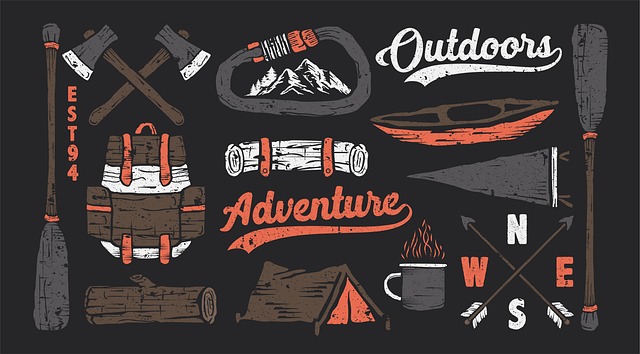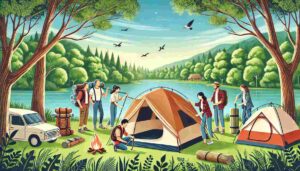Camping is a wonderful outdoor activity that allows us to disconnect from the hustle and bustle of daily life and reconnect with nature. However, for a successful and enjoyable camping trip, it is essential to have well-maintained gear. This not only ensures the longevity of your gear but also enhances the overall camping experience. That’s why in this article, I’ll provide you with top tips and tricks for keeping your camping gear in top shape.
I will cover a range of camping gear, including tents, sleeping bags, backpacks, and cooking gear, and provide essential maintenance techniques and tips for each type. Additionally, I will also discuss when it is time to replace gear and the benefits of doing so. By the end of this article, you will have a comprehensive understanding of how to keep your camping gear in top shape for many successful camping trips to come.
Understanding Your Camping Gear
Types of Camping Gear. Camping gear can range from essential to luxurious. Some common types of camping gear include tents, sleeping bags, backpacks, stoves, lanterns, and coolers. Each type of gear serves a specific purpose and requires different maintenance techniques.
How Different Types of Gear Should be Maintained. Tents, for example, need to be cleaned and waterproofed regularly to ensure they remain in good condition and are ready for use on the next camping trip. Sleeping bags, on the other hand, need to be cleaned and maintained to keep their insulation intact. Backpacks should be cleaned and repaired as needed, and cooking gear should be cleaned and maintained to prevent rust and ensure it functions properly.
Importance of Reading Manufacturer’s Care Instructions. It is important to read the manufacturer’s care instructions for each piece of camping gear to ensure it is being maintained correctly. The manufacturer’s instructions will provide specific information on how to care for the gear and any special considerations that need to be taken into account. Failure to follow these instructions can result in damage to the gear and potentially void any warranty.
Essential Maintenance Techniques for Common Camping Gear
Tents
- Cleaning and Waterproofing. Clean the tent regularly and reapply waterproofing spray as needed to maintain its waterproof properties. This will prevent leaks and ensure the tent remains in good condition for future trips.
- Storing and Transporting. When not in use, store the tent in a cool, dry place. When transporting the tent, make sure it is packed in a protective bag to prevent damage.
Sleeping Bags
- Cleaning and Loft Maintenance. Clean the sleeping bag after each use and store it in a cool, dry place. Avoid compressing the sleeping bag, as this can affect its loft and insulation properties.
- Storing and Transporting. Store the sleeping bag in a large, breathable storage bag to maintain its shape and insulation properties. When transporting the sleeping bag, make sure it is packed in a protective bag to prevent damage.
Backpacks
- Cleaning and Repairing. Clean the backpack after each use and repair any tears or damages as soon as they occur. This will extend the life of the backpack and ensure it is ready for use on the next trip.
- Storing and Transporting. Store the backpack in a cool, dry place, and make sure it is packed in a protective bag when transporting it.
Cooking Gear
- Cleaning and Maintaining Stoves and Pots. Clean the stove and pots after each use and maintain the fuel source to ensure it functions properly. This will prevent rust and ensure the gear is ready for use on the next trip.
- Storing and Transporting. Store the cooking gear in a cool, dry place and make sure it is packed in a protective bag when transporting it.
Tips for Maintaining Specific Camping Gear
Tents
- Repairing Tears and Leaks. Repair any tears or leaks in the tent as soon as they occur to prevent further damage. Use a tent repair kit or seek professional repair services if necessary.
- Maintaining Tent Poles. Tent poles should be inspected regularly for any damage or bending. Bent poles can be straightened using a tent pole repair kit, and any damaged poles should be replaced to ensure the tent remains functional.
Sleeping Bags
- Addressing Clumping and Compression. Sleeping bags can become clumped or compressed over time, affecting their insulation properties. To address this, shake the sleeping bag out regularly and store it in a large, breathable storage bag.
- Repairing Tears and Holes. Repair any tears or holes in the sleeping bag as soon as they occur to prevent further damage and maintain its insulation properties.
Backpacks
- Repairing Straps and Zippers. Repair any damages to the straps or zippers of the backpack as soon as they occur to ensure the backpack remains functional.
- Maintaining the Waterproofing of Your Backpack. Maintain the waterproofing of your backpack by cleaning it after each use and reapplying a waterproofing spray as needed.
Cooking Gear
- Preventing Rust on Metal Parts. Prevent rust on metal parts of cooking gear by cleaning it after each use and storing it in a dry place.
- Cleaning and Maintaining Fuel Sources. Clean the fuel source and maintain it regularly to ensure the cooking gear functions properly and is ready for use on the next trip.
When to Replace Your Camping Gear
Factors to Consider When Deciding to Replace Gear
- Age of the gear: Over time, camping gear can become worn and damaged, reducing its effectiveness and overall performance.
- Condition of the gear: If a piece of gear is heavily damaged or worn, it may be time to replace it.
- Frequency of use: If you use your camping gear regularly, it may need to be replaced more frequently.
Signs that Indicate it’s Time for Replacement
- Tears and holes in tents and sleeping bags
- Bent or damaged tent poles
- Stains and discoloration on sleeping bags
- Worn or damaged straps and zippers on backpacks
- Rust on metal parts of cooking gear
- Leaks in stoves or pots
Benefits of Replacing Old Gear
- Improved performance: New gear is more likely to perform better and last longer than old, worn gear.
- Enhanced camping experience: With well-maintained gear, you can enjoy a more comfortable and enjoyable camping experience.
- Increased safety: Properly functioning gear can help ensure your safety while camping.
- Reduced environmental impact: Replacing old, worn gear with new, more environmentally friendly gear can reduce your impact on the environment.
If you are on a tight budget check this guide: Budget Camping Gear: How To Find Affordable And High-Quality Options
Conclusion
Camping gear maintenance is an essential part of preparing for a successful camping trip. Proper maintenance ensures the longevity of your gear and enhances the overall camping experience.
By following the top tricks for keeping your camping gear in top shape in this article, you can keep your camping gear in good shape for many successful camping trips to come. Regular cleaning, repairing, and storage are key to maintaining gear, and replacing old gear when necessary can improve performance and ensure safety.
I encourage you to make gear maintenance a priority and to follow the tips and recommendations outlined in this article. By doing so, you can enjoy many comfortable and successful camping trips in the future. Happy camping!










